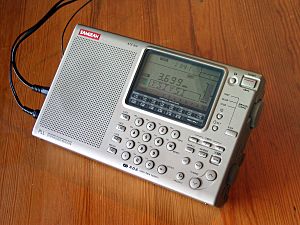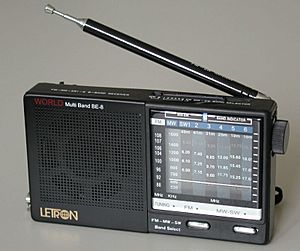Communications receiver facts for kids
A communications receiver is a special type of radio receiver. Think of it as a super-powered radio! While a regular radio (like the one in your car or home) is made for listening to music or news on popular stations, a communications receiver can pick up many more signals. It's used to hear things like shortwave radio broadcasts from far away, or conversations between ham radio operators. It's often paired with a radio transmitter to create a two way radio system, allowing people to talk back and forth.
What Makes Them Special?
Communications receivers are built to be very stable and reliable. This means they work well for a long time, even if used all day, every day. They are also often designed so you can control them from a distance.
These radios have more controls than a simple broadcast radio. Here are some cool features you might find:
- Signal Strength Meter: This shows you how strong the radio signal is.
- RF Gain Control: This helps you adjust how sensitive the radio is to incoming signals.
- Bandwidth Filters: These are like special "earplugs" for the radio. They help you focus on just one signal and block out noise or other nearby signals.
- BFO Tuning: This helps you tune in to certain types of signals, like Morse code.
- Digital Displays: Many modern receivers have clear digital screens that show you the exact frequency you are listening to.
- Strong Build: Unlike old radios that might have been in wooden boxes, communications receivers are usually in tough metal cases. This protects them and helps block out unwanted electrical noise.
Old School Radios: "Boatanchors"
Communications receivers started becoming a special type of product around 1933. The older ones, which used vacuum tubes, are sometimes called "boatanchors." This is because they are very big and heavy, just like a boat anchor! Some famous "boatanchor" radios include the Collins R-390 and the RCA AR-88. Even some newer, solid-state receivers can be quite large and heavy.
Images for kids





